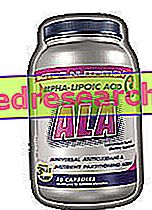What is that
Soy sauce ( Shoyu or Shoya for the Japanese, Teu-Yu for the Chinese) is a liquid seasoning, with a blackish color, a strongly aromatic smell and a distinctive flavor, distinctly sapid (similar to that of meat extracts).

Originally, soy sauce was born as a fermented product based on the homonymous legume; on the other hand, today many soy sauces contain a good portion of cereals and other ingredients different from the traditional one. For example, only soybeans are used in Chinese soy sauce, while both Japanese legume and roasted wheat or barley are used in the Japanese soy sauce.
In general, CONTEMPORARY soy sauce could be defined as "a condiment obtained from the fermentation of different vegetables (legumes and cereals) in water and salt". A very similar product is the Tuong of the annamiti.
Microbiological aspects
Generally, soy sauce is the fruit of DOUBLE fermentation of certain plant ingredients that make it up.
The first process is of fungal origin, due to the intervention of fungi belonging to the Species Aspergillus orza (called Koji ); the second occurs in brine, due to the intervention of bacteria belonging to the genus Tetragenococcus . Of these, the Species halophilus (the most used) can tolerate concentrations of salt (sodium chloride - NaCl) up to 18% of total volume and is the most present in the various preparations in brine. Obviously, not ALL the microorganisms of the genus Tetragenococcus are typical of the aforementioned process, although many others are equally (or even more) halotolerant; for example, the Specie muriaticus, responsible for the production of histamine, is well present in other foods much more savory than soy sauce, such as the fermented cuttlefish liver sauce (NaCl equal to 25%).
NB . Although the soy sauce makes use of the bacterial action of halophilus and not of muriaticus, it is nevertheless mentioned in the list of foods to be avoided in the event of FOOD INTOLERANCE TO THE ISTAMIN.
Outline of Production
After the classic preliminary operations of washing and preparation of raw materials (including soya cooking and possible roasting of cereals), the production of this sauce involves the conservation of the various ingredients in barrels for a period of time ranging between 8 months and 5 years (fermentation). At the end, for a high quality product, the liquid part is decanted and the solid part is squeezed; then, to the residue of the pressure other salted water is added and it is squeezed again, obtaining a product of inferior quality; for information, the residues of the second pressing are used as agricultural fertilizer.
WARNING! Not all soy sauces are produced using the traditional system and some are subjected to acid hydrolysis of soya beans.
Chemical composition
Composition for: 100g of Soy, Sauce - Reference values of the INRAN Food Composition Tables Nutritional values (per 100 g of edible portion)
| ||||||||||||||||||||||||||||||||||||||||||||||||||||||||||||||||||||||||||||||||||||||||||||||||||||||||||||||||||||||||||||||||||||||||||||
The analysis and chemical estimation of soy sauce are not simple operations, since there are various types and with completely different maturation levels.
The Japanese ones reveal that the product contains a percentage of: water for 60-74%, nitrogenous substances for 4-10%, fats for 0.5%, non-nitrogenous extractive substances for 4-11%, free acids for 1% (0.1-0.2% volatile), 0.4% alcohol and 10-25% mineral salts.
Nutritional Features
Soy sauce is a liquid condiment made from legumes and cereals. It is NOT suitable for the celiac diet, as (if prepared with wheat or barley) it probably provides traces of gluten.
From the energy point of view, soy sauce is quite light but not entirely ACALORIC. It contains a few grams of protein and (more or less) the same amount of simple carbohydrates, for a total of 17g / 100g. If we consider that 67.6g on 100g are water, the total would still be 15.4g. They mainly consist of the fixed residue, or mineral salts. Unfortunately, as many as 5.7g of these are sodium (Na) and it is conceivable that at least the same quantity comes from chlorine (Cl). On balance, only 4g affect potassium, calcium, iron, etc.
The abundance of sodium in soy sauce is the only contraindication evident to its consumption. Probably, due to the method with which it is consumed (with wasabi for the sushi sauce or mixed with other preparations), not everyone realizes that 100g of soy sauce make 1000% (10 times) of the minimum recommended ration for this mineral; to be honest, 100g of soy sauce contains a quantity of sodium that is about 20% higher than the MINIMA daily risk threshold due to the onset of ARTERIAL HYPERTENSION. Furthermore, only one spoon of the food covers the daily sodium requirement (estimated at 575mg).
Ultimately, soy sauce is a food that does NOT lend itself to the high blood pressure diet and the celiac diet; moreover, even for those who are NOT at risk of hypertension, a limited consumption is recommended.



